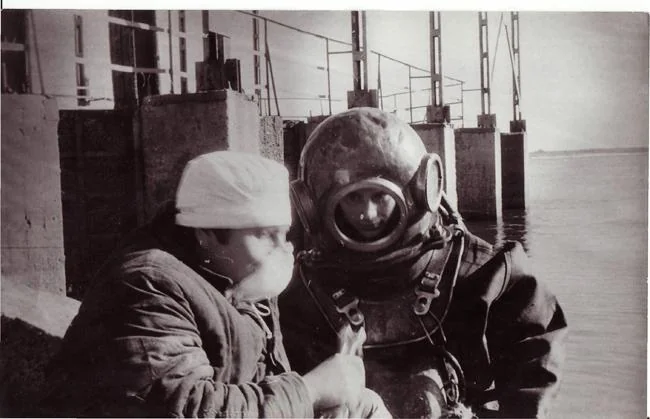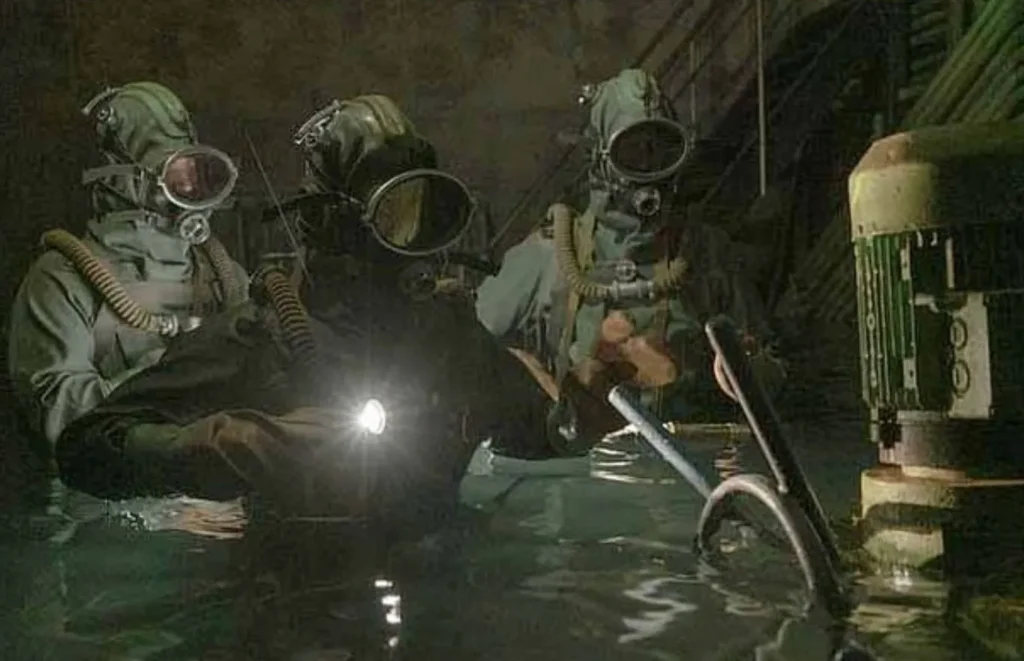How far would you go for your job? Would you do something dangerous?
What if your job asked you to do something that could mean certain death, but would save millions? This is what was asked of three unsung heroes of the world, the Chernobyl divers.
In 1986, one of the most devastating nuclear disasters in world history occurred: the meltdown of Chernobyl’s Reactor 4.
Hundreds of thousands of firefighters and liquidators were there to clean up the unimaginable mess left behind by the meltdown of Reactor 4. But separate from these heroes, three others get less recognition.
Only three divers performed what might have been the most important part of the entire Chernobyl cleanup. Who were these divers, and why was their job so important?

Who Were the Chernobyl Divers?
Before the Chernobyl divers were given their legendary, dangerous task, they were just men who worked at the Chernobyl Nuclear Power Plant.
Here is a miniature bio on each of these three men:
- Alexei Ananenko
- Position: Mechanical engineer
- Bio: Born in 1962, Alexei had worked at Chernobyl for some time when the disaster struck. His knowledge of the plant made him a valuable member of the three-man diving team.
- Valeri Bezpalov
- Position: Senior Engineer
- Bio: Bezpalov, born in 1955, had experience on his side when it came time to undertake the all-important diving mission. He was incredibly familiar with the plant’s systems and structures–something that was of the utmost importance when they were in the water.
- Boris Barnov
- Position: Shift Supervisor
- Bio: One of the most important leaders amid the Chernobyl disaster was Boris Baranov, the shift supervisor on duty when the meltdown occurred. He didn’t shy away from duty and was hands-on during the cleanup process and dive.
Why Were the Chernobyl Divers Needed?
In the early hours of April 26, 1986, Reactor 4 at the Chernobyl Nuclear Power Plant experienced a critical meltdown. Explosions and fire followed, which had to be swiftly dealt with. Dozens of people were killed that week.
Thousands of others would perish in the coming years. The world had never seen anything like the Chernobyl Disaster before, but it could have been a lot worse.
When the first explosions occurred, firefighters rushed to put the blazes out, pumping water into the now-exposed reactor, and flooding the basement. The water succeeded in putting out the fires, and in the rush to control the situation, no one considered the consequences of the flooded basement.
But as the days passed, experts came to a horrifying conclusion. The reactor was still melting down, burning through the concrete floor, and was well on its way to making contact with the bubbler pools beneath the reactor.
These pools were massive, said to contain nearly 20 million liters of water that would be used as coolant for the reactor. But the reactor was still blazing hot. If it made contact with this enormous amount of water, the steam explosion that occurred would be catastrophic on an almost unimaginable scale.
The water was already contaminated with radiation. The explosion would be strong enough to destroy the entire rest of the Chernobyl plant, as well as the three remaining intact reactors.
The contaminated water combined with the nuclear fallout from such an explosion was estimated to be severe enough to destroy half of Europe. It would cause it to be uninhabitable for 500,000 years or more.
The good news: there were valves that, when pulled, would drain these bubbler pools.
The bad news: The valves were located in the basement, and as we mentioned before, said basement was flooded with even more irradiated water.
The basement was dark, and while firefighters were working to pump the water out to make the valves easier to access, they couldn’t accomplish their task in enough time. This is where our heroes come in.
Alexei, Boris, and Valeri volunteered to be the men who would enter the basement and find the valves in the dark. The basement wasn’t a small space, and time was running out. So, dressed in only wetsuits and carrying flashlights, they set out to save the world.

The water was around their knees, but the dark was more troublesome. The trio knew that their mission was likely a fatal one–they were wading in radioactive water after all–but it had to be done.
Minutes passed, and hope was slipping away when one of the men spotted a pipe that they were able to follow. At the end of the pipe, they found exactly what they had been searching for– the drainage valves.
The three men twisted the valves, and the pools beneath the reactor began to drain. They had done it–they had prevented an explosion that could have turned the Chernobyl Disaster into a cataclysmic event.
Did the Chernobyl Divers Survive?
All three divers had accepted before they entered the basement, that their lives could be over. It was expected they would die from the same sickness that killed other exposed Chernobyl workers–ARS, or Acute Radiation Syndrome.
Amazingly, all three divers survived long term. Not only that–they were awarded the Order For Courage by Ukrainian President Petro Poroshenko in 2018. Unfortunately, Boris Baranov passed away in 2005 from a heart condition and was awarded the honor posthumously.
How Did the Chernobyl Divers Survive?
Several factors prevented the divers from getting ARS, but one of the most surprising was the water itself. Water is an amazing absorber of radiation, making it much less dangerous than previously thought.
Their suits also provided them some protection. Protective gear was given to all liquidators, firefighters, and divers.
Lastly, the three men worked as quickly as they could to minimize their exposure to the radiation. The mission was still extraordinarily dangerous, but a couple of positive variables and the three men’s expertise meant that they survived one of the most treacherous jobs in the entire Chernobyl disaster.
References
“Five Things You Probably Didn’t Know About Chernobyl”-Douglas E. Hardtmayer https://www.ans.org/news/article-2044/five-things-you-probably-didnt-know-about-chernobyl/
“Chernobyl: A Short History of the Human Impact on Ukraine and its Neighbors”- Lisa Horner https://geohistory.today/chernobyl-short-history-human-impact/

